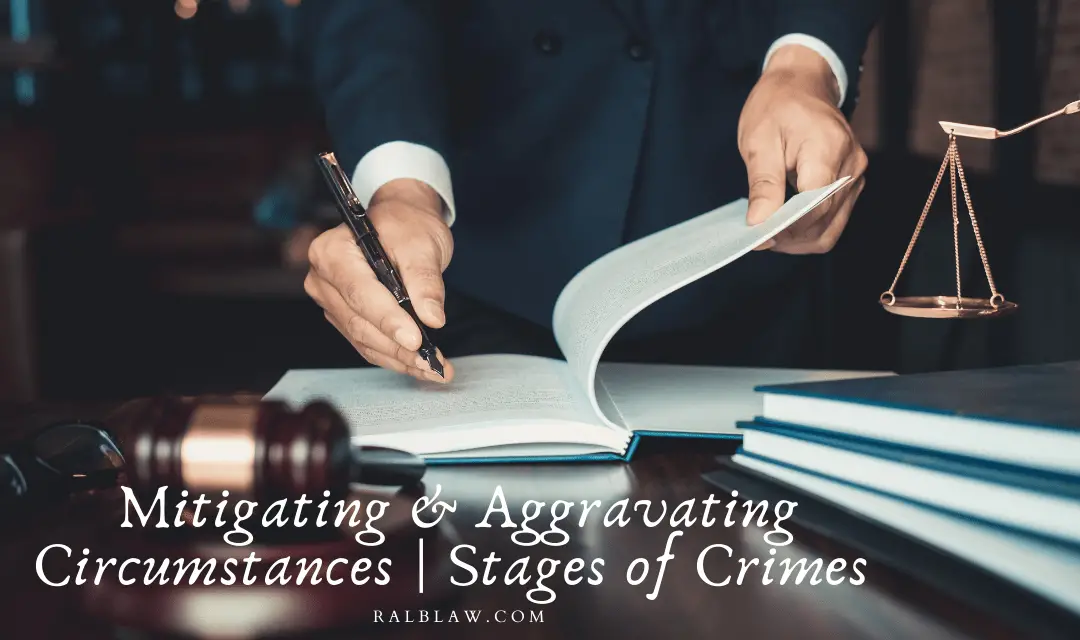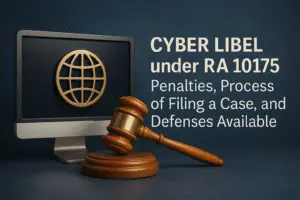Mitigating circumstances are defined as the factors that reduce the severity or culpability of certain criminal act or acts of the offender, such as but not limited to, the age, mental capacity, least intention, and confusion, among others. These circumstances are found under Article 13, Chapter III, of the Revised Penal Code of the Philippines [Revised Penal Code].
There are types of mitigating circumstances, which may affect the actual imposition of the penalty, whether in the reduction of a period or degree of the imposable penalty. This finds significance in the kinds of mitigating circumstances that existed during the commission of the offense.
These are the Generic Mitigating and Privilege Mitigating. It must be remembered that, in Mitigating Circumstances, the criminal act committed by the offender will not change. It is only the penalty imposed that was affected.
On the other hand, Aggravating circumstances are situations pursued by the offender or violator to insure the successful conclusion of his or her criminal design, plan, and/or execution. These circumstances may also affect one’s criminal liability, specifically in the ultimate imposition of the appropriate penalties for his/her unlawful wrongdoings.
Examples of this situations, inter alia, are felony committed by a band, disregard of rank or sex, unlawful entry, treachery, abuse of superior strength, and those others specifically mentioned in Article 14 of the Philippine Penal Code.
Distinction between Ordinary and Privileged Mitigating Circumstances
| Periods of Penalties | Degrees of Penalties |
|---|---|
| Minimum | Arresto Menor [1 to 30 Days] |
| Medium | Arresto Mayor [31 Days to 6 Months] |
| Maximum | Prision Correcional [6 Months & 1 Day to 6 Years] |
| Prision Mayor [6 Years & 1 Day to 12 Years] | |
| Reclusion Temporal [12 Years & 1 Day to 20 Years] | |
| Reclusion Perpetua [20 Years & 1 Day to 40 Yeas] | |
| Death [Suspended] |
As to the application
Generic or Ordinary Mitigating allows the reduction of the period on the penalty imposed such as the minimum, medium, and maximum period, except when there is a presence of an aggravating circumstance or several thereof.
For example, the imposable penalty for the felony [Homicide] supposedly committed by an offender is Reclusion Temporal, and he was able to prove one (1) ordinary mitigating circumstance. No generic aggravating circumstances have been proved. In this case, his penalty would be reduced to Reclusion Temporal in its minimum period. For every mitigating circumstance present in the criminal act, one period within the penalty imposed will be deducted therefrom, until the applicable period is the minimum..
On the other hand, Privilege Mitigating is the lowering of the penalty imposed, either by one or two degrees, as the case may be. Hence, if the offender has been sentenced to suffer the penalty of Prision Mayor, by applying the Privilege Mitigating, his penalty will be reduced to Prision Correcional.
- One example of a Privilege Mitigating Circumstance is when the offender has committed incomplete justifying or exempting circumstances. If the requisites of the justifying circumstance are lacking because there is no sufficient provocation on the part of the offended party, the penalty to be imposed upon the offender will be reduced to one degree lower.
- Another is minority.
- It must be noted also that, if there are two mitigating with no aggravating circumstance, the two mitigating circumstances become one [1] Privilege Mitigating.
As to the Effects on Aggravating Circumstances
In the presence of aggravating circumstances, the offsetting rule can be applied in generic mitigating. It has no effect on privileged ones.
Meaning, if there is one privilege mitigating, the same will be prioritized in application, without regard to the presence of one or more generic aggravating.
For example, the offender is a minor of 16 years old, and he committed a felony, the imposable penalty of which, under the law, is Reclusion Temporal.
Attendant also in the commission of the offense is one (1) aggravating. Since minority is a privilege mitigating, the imposable penalty will be immediately reduced by one (1) degree. It will now become Prision Mayor.
What about the presence of one aggravating in that scenario? Since there is also one (1) aggravating, the same will be applied to increase the penalty within the degree of Prision Mayor to be imposed in its maximum period.
On the other hand, if the circumstances, aggravating and mitigating, are both ordinary and generic, offsetting will be utilized, thereby, cancelling each other respectively.
If one or more circumstances will remain after offsetting, such will be applied accordingly by increasing or decreasing the period, as the case may be, within the degree of a specific penalty [refer to the table above].
How does Qualifying Aggravating Circumstance differ from Generic Aggravating Circumstance?
Aggravating Circumstances are circumstances that exacerbate the penalty of a particular offense. If the commission thereof is attended by these circumstances, the penalty for the crime committed shall be increased, whether in terms of period or degree [refer to he table above].
Generic Aggravating Circumstances are aggravating circumstances that are found under Article 14 of the Revised Penal Code. If extant, they can be applied to felonies defined and penalized under the said penal code. These circumstances, if they exist in the commission of the crime, will increase the penalty by period.
The Revised Penal Code particularly, Article 14 thereof, enumerates the following circumstances which aggravate the criminal liability of a particular offender.
It is noted that in the presence of any mitigating circumstances, a Generic Aggravating Circumstance may offset or compensated by a mitigating circumstance, correspondingly.
Generic Aggravating Circumstances, among others, under the said Article of the Revised Penal Code are enumerated as follows:
- Contempt or insult of public authorities,
- Taking advantage of public position,
- Recidivism
- Night time, uninhabited place, or band,
- Abuse of confidence or obvious ungratefulness,
- Place and time of commission of offence,
- Committed in the dwelling of the offended party,
- Breaking parts of the house,
- Unlawful entry,
- Habituality, and
- Craft, fraud or disguise.
- Ignominy
- Cruelty
- Treachery
- Evident Premeditation
- Abuse of Superior Strength
- With the Aid of Armed Men
- Felony Committed by a Band
Qualifying Circumstances are aggravating circumstances, likewise. Nevertheless, if attended in the commission of the crime, such will change the nature of the felony. As a result, and foremost, the penalty to be imposed on such offense will be increased by degree [refer to the table above].
While in the presence of generic aggravating circumstances, a mitigating circumstance may offset the former. In Qualifying Aggravating Circumstances, the presence of said mitigating, however, cannot cancel the qualified ones
Example of Qualified Aggravating Circumstance:
Under the Revised Penal Code, X killed Y, and it was proven that the killing was attended with treachery or “aleviosa”. Treachery here is considered as qualified aggravating circumstance which changed the nature of the crime. As treachery is used during the killing to insure its success, the felony becomes Murder rather than mere Homicide. The change in the nature of the crime will increase the penalty by degree [Ordinary killing (Homicide) – Reclusion Temporal to Qualified killing (Murder) – Reclusion Perpetua].
What are the stages in the Commission of a Crime?
In the commission of a felony, the act of the culprit passes through certain phases. These are the internal acts and external acts. The malefactor reaches the stage of his internal acts from the moment he conceives the idea of committing a felony.
The mere ideas of the felon or his intention to commit a felony, no matter how immoral, if not carried out, are not punishable.
Conversely, the external acts of the malefactor, as the second stage in the commission of a felony, cover his preparatory acts and his acts of execution. Ordinarily, preparatory acts are not punishable, unless these acts are considered by law as independent crimes such as the possession of picklocks under Article 304 of the Revised Penal Code of the Philippines.
Internal acts | Preparatory acts (generally not punishable)
A certain person harbors in his idea the desire to kill another. He decides to end the life of his victim through the use of poison.
Tus, when said person, with intent to kill someone, purchased a poison in a drugstore with which to kill his intended victim, he cannot be held criminally liable for attempted homicide or murder without first using this to accomplish his criminal objective.
The mere possession of a poison may be deemed to be for the purpose of killing rats or insects. Another example of a preparatory act is the carrying of inflammable materials to a place intended to be burned which also do not constitute attempted arson in the absence of the act of burning a portion of a particular place or establishment.
External Acts
The external acts, which are punishable under the Revised Penal Code, are the overt acts or acts of execution which establish that the intention of the criminal to commit a particular felony. This is more than a mere planning or preparation. There are three stages of the acts of execution of a felony.
The first stage is the attempted; the second stage is the frustrated; and the third and last stage is the consummated which are defined under Article 6 of the Revised Penal Code.
Attempted Felony
In attempted felony, the offender commences the commission of a felony directly by overt acts. Nonetheless, he has not performed all the acts of execution which should produce the felony by reason of some cause or accident other than his own spontaneous desistance.
It is to be noted that to constitute an attempted felony, first, there must be an overt act or some physical activity which indicates the intention of the offender to commit a particular felony.
An overt act, as compared to preparatory act, clearly establishes beyond reasonable doubt the intent of the accused to commit the supposed felony or crime by initiating it. It is free from any interpretation other than his intent to injure, kill, or prejudice his intended victim or commit a particular offense.
In the instance where the offender purchased a poison and mixed it with the food intended for his victim, and for some reason the victim threw away the food with poison, the offender is liable for attempted murder.
The accused’s intention to kill his victim by means of poison is clear when he mixed it with the victim’s food. Under Article 248 of the Revised Penal Code, killing a person by means of poison is murder.
Frustrated Felony
In frustrated felony, the offender must perform all the acts of execution which would produce the felony as a consequence, but which, nevertheless, do not produce it by reason of causes independent of the will of the perpetrator.
For instance, in the crime of homicide or murder, when the offender performs all the acts of execution sufficient to cause the death of his victim, but due to medical assistance given by a third person his victim survives, the crime is frustrated. However, if the victim dies, the offense is consummated.
Consummated Felony
In consummated felony, all the elements necessary for its execution and accomplishment are also present like in frustrated felony. The difference between the two is that in consummated felony, the crime is produced or the perpetrator succeeded in committing his criminal objective.




